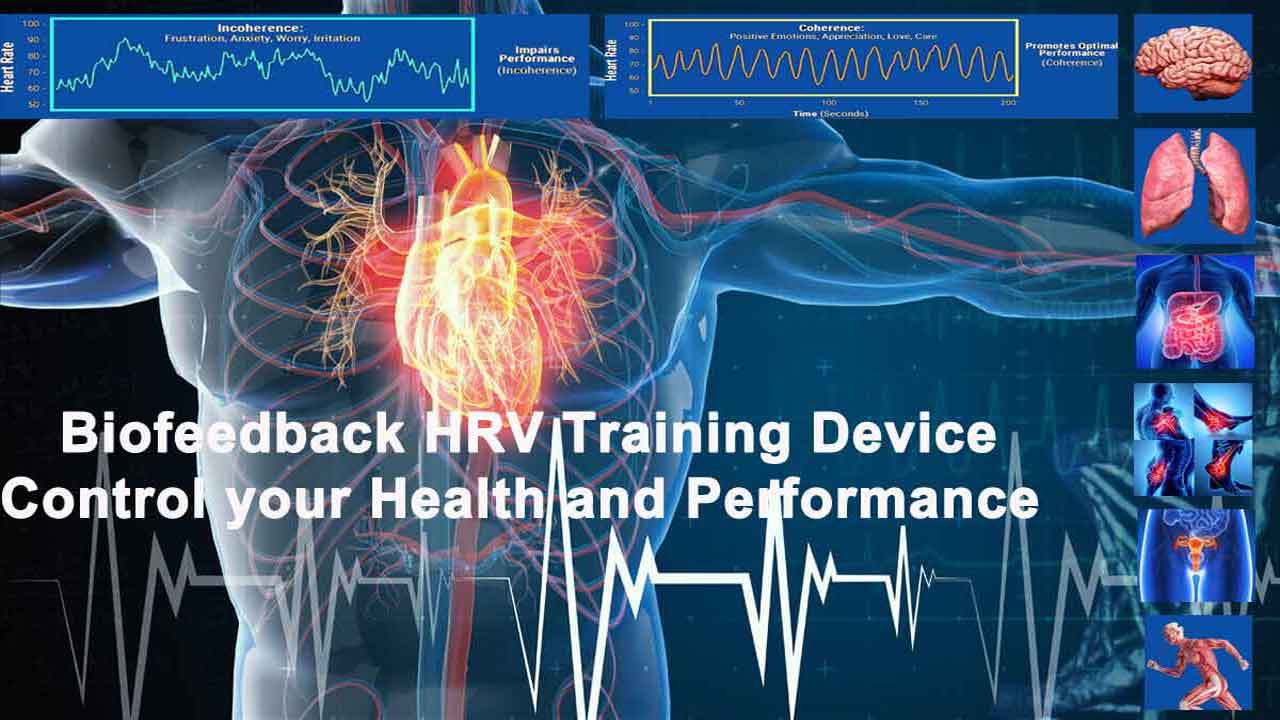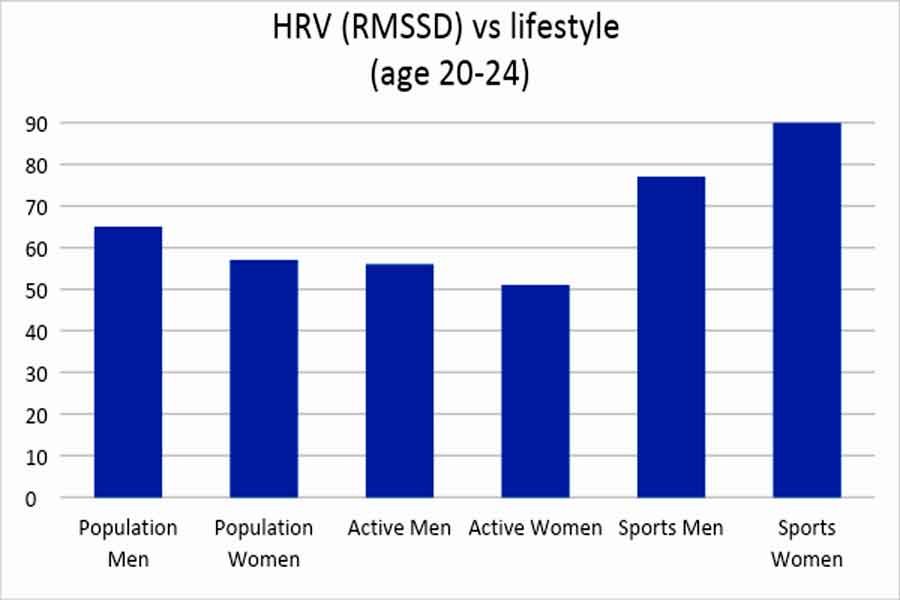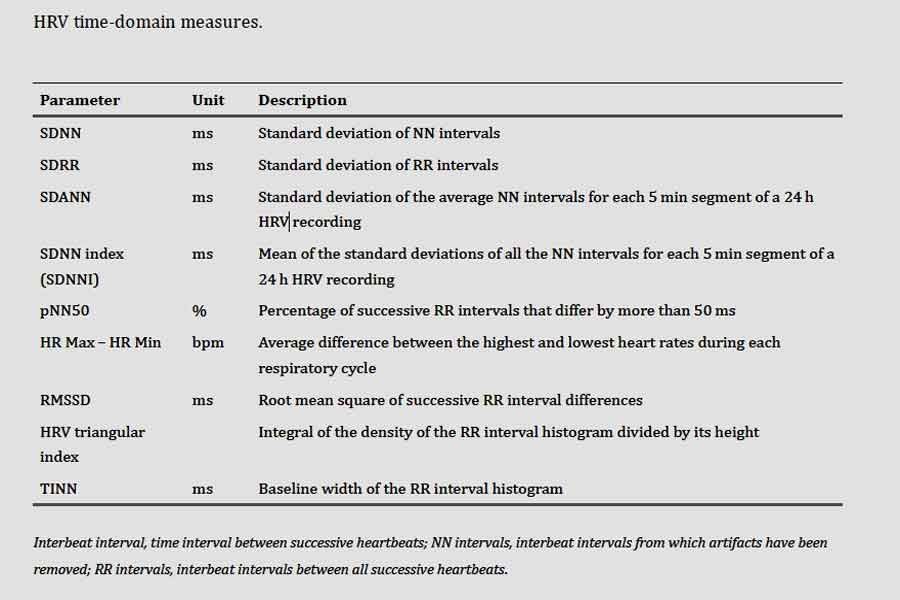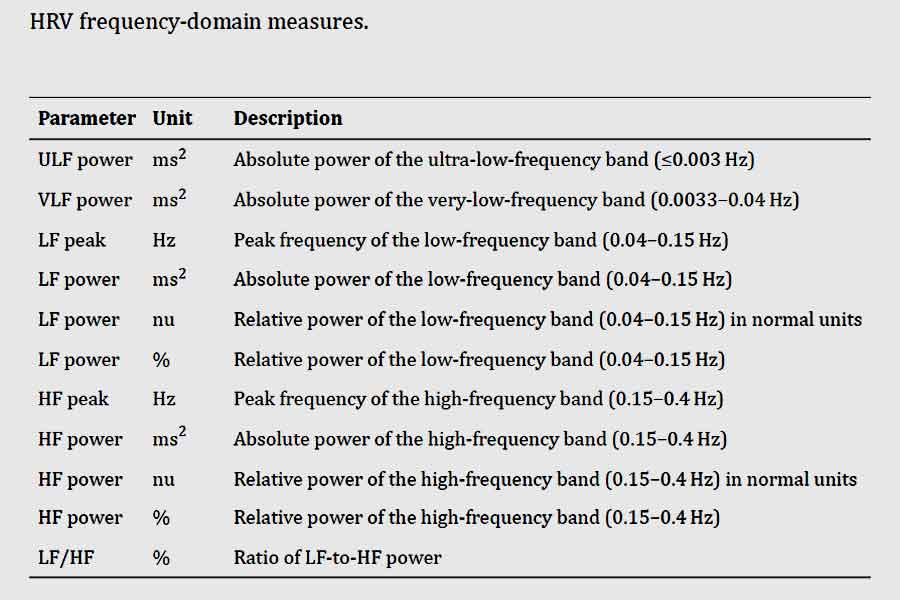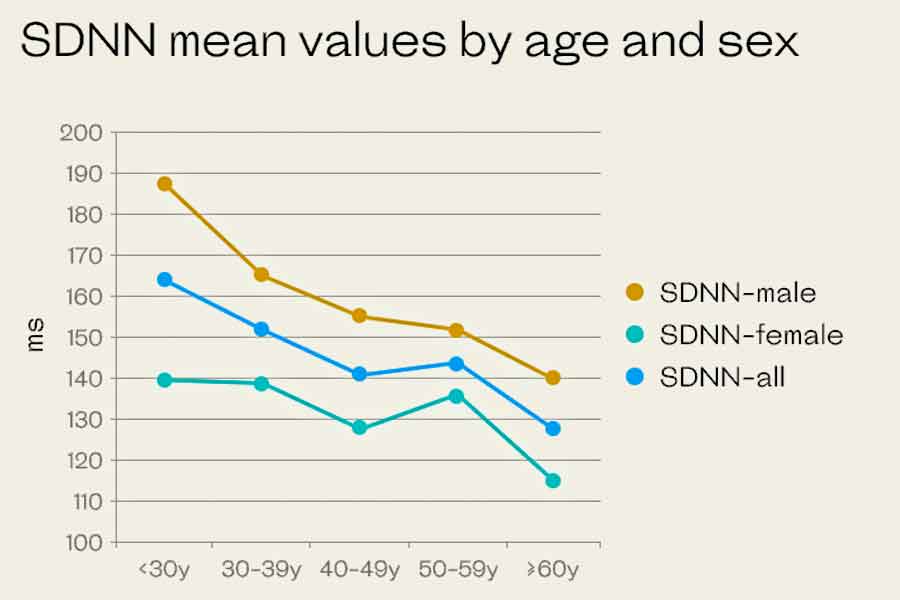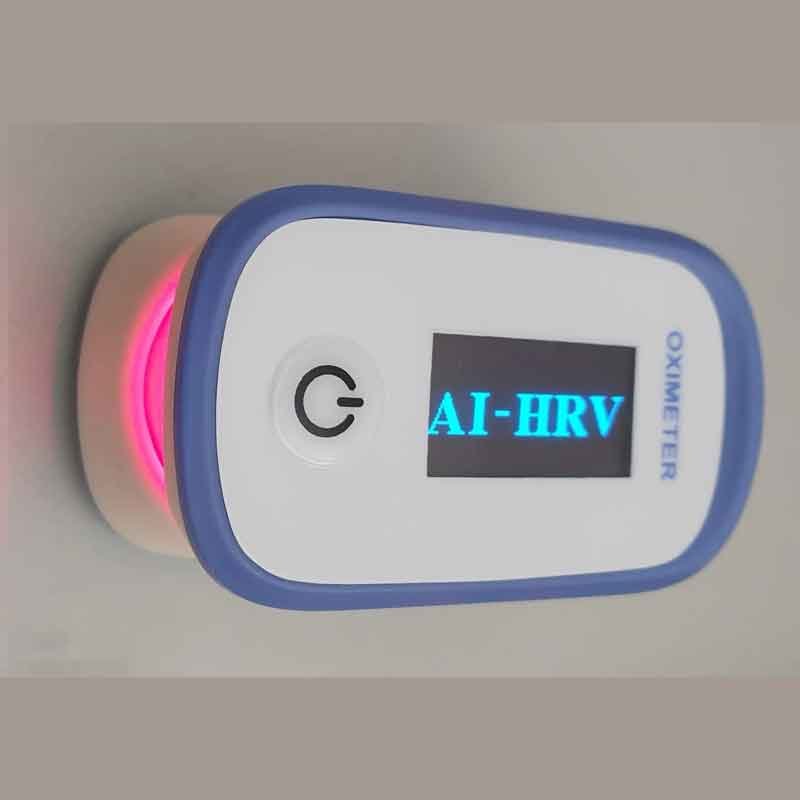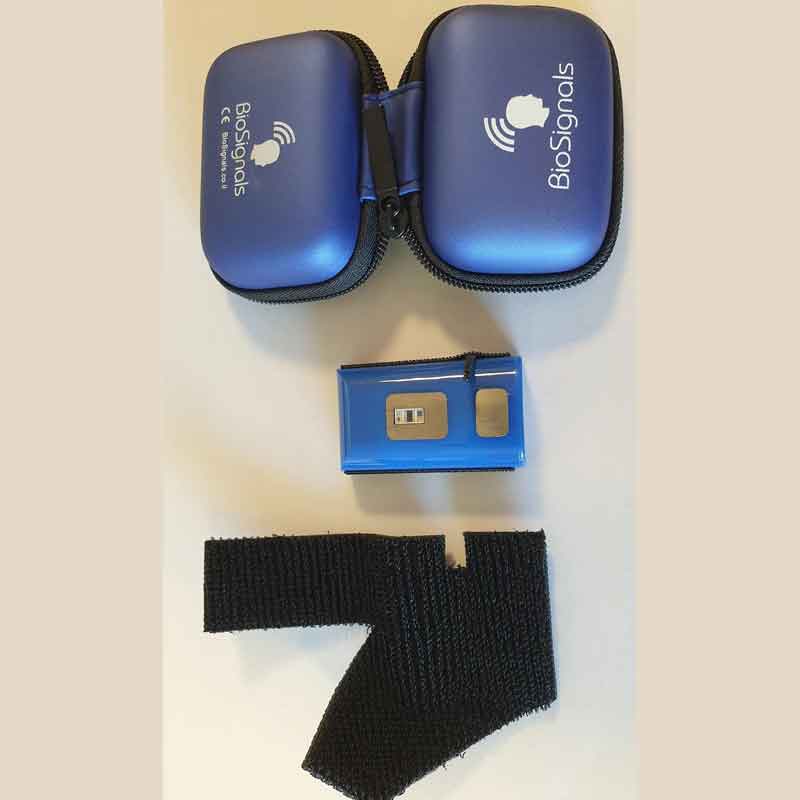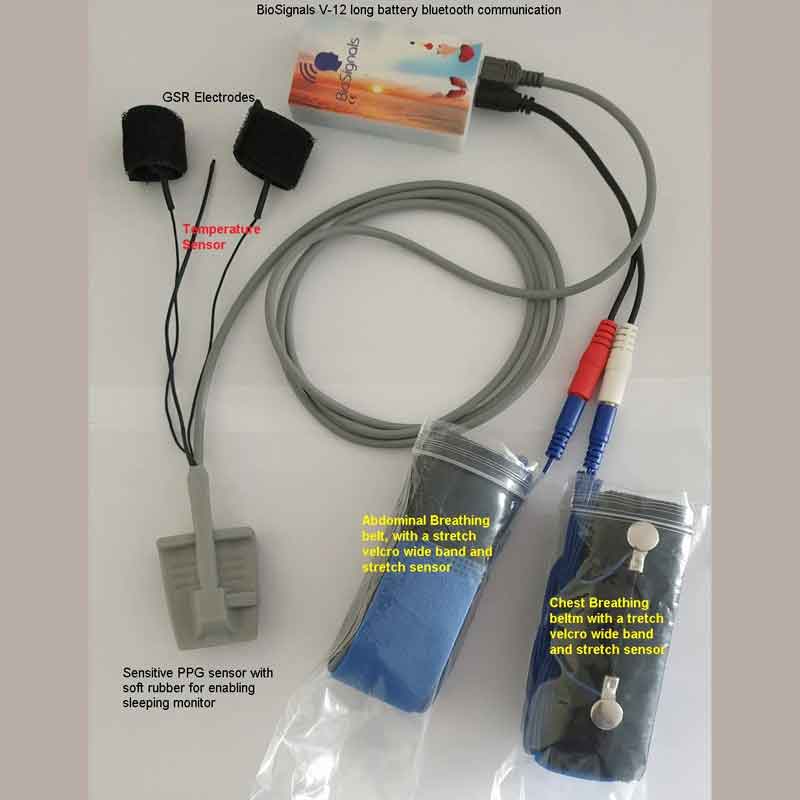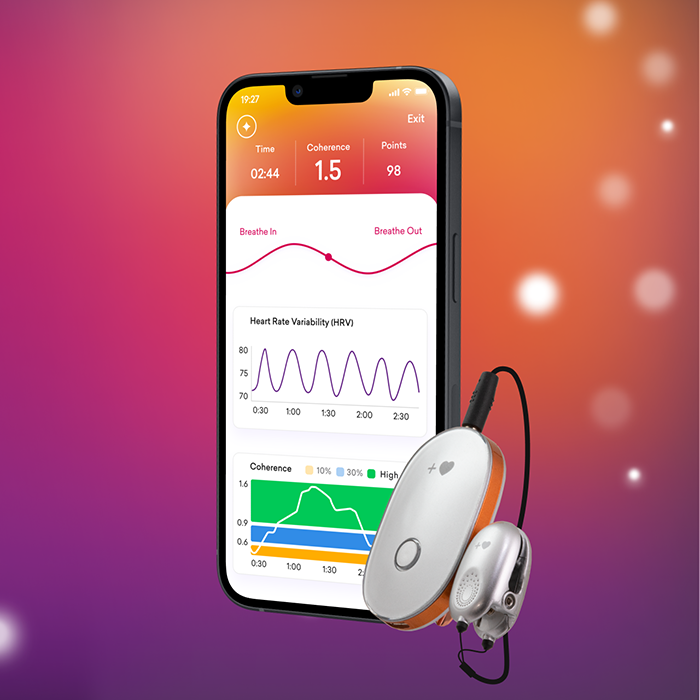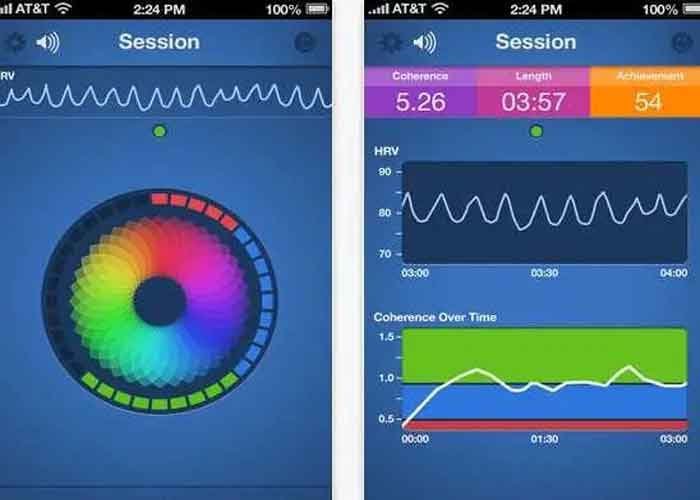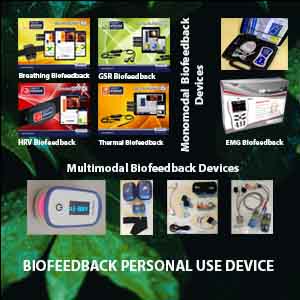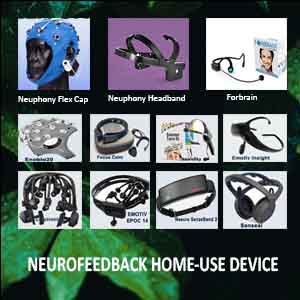Best HRV Biofeedback Training Device
The heart rate variability biofeedback device is a powerful tool for optimizing health and performance, offering real-time insights into the autonomic nervous system. HRV training devices help individuals monitor and improve their HRV, a key indicator of stress resilience, recovery, and overall well-being. By providing biofeedback, these HRV devices enable users to train their body’s response to stress, promoting a balanced nervous system and enhancing physical and mental performance. For those seeking the best HRV biofeedback device, understanding key features and functionalities is crucial to making an informed choice. In this article, we will explore the benefits, functionalities, and applications of HRV training devices, shedding light on how they can be an essential part of a wellness or performance optimization routine.
Table of Contents
Toggle- Best HRV Biofeedback Training Device
- Understanding the Importance of HRV Training
- How Biofeedback HRV Training Device Enhance Training Efficiency
- Applications of the Biofeedback HRV Training Device
- Decoding HRV Parameters: Insights into Autonomic Regulation and Stress Responses
- Deciphering Choices: Exploring Biofeedback HRV Training Device
- Types of Biofeedback HRV Training Devices and Their Applications
- Decoding HRV Devices: Parameters, Purposes, and Precision
- Biosignals Biofeedback AI-HRV training device
- Biosignals Biofeedback Wireless HRV training Finger Device With 3 Sensors. Professional Product For Clinical Or Home Use.
- Biosignals Biofeedback HRV training Device with 5 Sensors and Bluetooth for Professional Clinical Or Home Use
- HeartMath
- Elite HRV training device
- Comparing Biofeedback HRV Devices. What is the Best HRV Biofeedback Device?
- Optimal Training: A Step-by-Step Approach with Your Best HRV Biofeedback Device
- Breaking Barriers: Addressing Common Misconceptions in HRV Training Devices
- FAQ: Best HRV Biofeedback Training Device
Understanding the Importance of HRV Training
Comprehending the intricacies of heart rate variability (HRV) is paramount in fitness and well-being. HRV is a nuanced indicator of the autonomic nervous system’s activity, providing valuable insights into the body’s readiness for physical exertion and recovery. This chapter aims to unravel the significance of HRV in the context of training, shedding light on the crucial role it plays in optimizing performance and overall health.
Explore the Significance of Heart Rate Variability (HRV)
At its core, HRV reflects the variations in time intervals between successive heartbeats, offering a window into the body’s adaptability and resilience. Unlike a static heart rate measurement, HRV provides a dynamic perspective, showcasing the balance between the sympathetic and parasympathetic branches of the autonomic nervous system and is a potential stress indicator. An average HRV for adults generally ranges from below 20 to over 200 milliseconds.
Generally, a higher HRV (over 50 ms during the daytime at rest and 114 ms during sleep) indicates healthy ANS function. In contrast, a low HRV indicates sympathetic dominance, parasympathetic and autonomic dysregulation, and reduced resilience and regulation of our body’s functions.
Understanding HRV’s significance goes beyond traditional measures of cardiovascular health. Moreover, it is a powerful tool for athletes and fitness enthusiasts. By providing real-time feedback, HRV reveals the body’s ability to manage training loads, handle stress, and support recovery. As a result, when we delve deeper into HRV, we can see its role as a critical performance indicator.
Unveiling the Key Role of Biofeedback in HRV Training
Enter the Era of HRV Training Devices: Biofeedback is now at the forefront of optimizing training outcomes through HRV. These advanced devices not only monitor HRV but also provide actionable insights. As a result, they create a feedback loop that allows individuals to adapt their training regimens based on real-time physiological data.
Personalized Biofeedback for Tailored Training: The biofeedback component introduces a customized dimension to HRV training. This ensures that the individual’s unique responses influence their workouts’ intensity, duration, and timing. Moreover, by revealing the intricate relationship between HRV patterns and the body’s readiness, biofeedback-enabled HRV training devices allow users to make more informed decisions. Ultimately, this fosters a holistic approach to fitness that adapts to each person’s specific needs.
How Biofeedback HRV Training Device Enhance Training Efficiency
Enhancing Training Efficiency with Biofeedback HRV Devices
In HRV training, integrating biofeedback through advanced HRV training devices marks a significant paradigm shift in optimizing training efficiency. These sophisticated devices monitor Heart Rate Variability (HRV) and provide real-time insights, creating a dynamic feedback loop. Consequently, individuals are empowered to maximize the effectiveness of their training regimens and achieve more efficient progress.
1. Personalized Training Guidance
Biofeedback HRV training devices offer a personalized approach by continuously analyzing HRV patterns. This real-time feedback, in turn, allows users to tailor their training intensity, duration, and frequency based on their unique physiological responses. As a result, individuals can ensure a customized and efficient workout plan.
2. Adaptive Stress Management
One key role of biofeedback in HRV training devices is gauging stress levels. By providing immediate feedback on stress responses, individuals can adapt their training sessions to effectively manage stressors, fostering a balanced autonomic nervous system and optimizing overall training efficiency.
3. Optimal Recovery Strategies
Biofeedback HRV training devices contribute to efficient recovery strategies. By assessing HRV metrics, these devices help users determine the ideal timing and intensity of recovery activities. As a result, they ensure that the body is adequately prepared for subsequent training sessions.
Real-Time Performance and Long-Term Training Benefits
4. Real-Time Performance Evaluation
Biofeedback’s real-time nature enables instantaneous performance evaluation. Users can gauge their physiological responses during exercise, allowing on-the-fly adjustments to optimize performance and prevent overtraining, enhancing overall training efficiency.
5. Goal-Oriented Training Plans: Best biofeedback HRV device assist in establishing goal-oriented training plans. By tracking HRV trends over time, users can set realistic and achievable fitness goals. Moreover, the biofeedback loop ensures that training remains aligned with these objectives, maximizing efficiency in reaching desired milestones.
6. Motivational Reinforcement: Biofeedback HRV training devices provide constant feedback, a motivational tool. Positive reinforcement from improving HRV metrics encourages individuals to stay committed to their training routines, fostering consistency and enhancing overall training efficiency.
7. Preventing Overtraining Risks: Biofeedback helps identify early signs of overtraining. By monitoring HRV variations, individuals can adjust their training loads, thereby preventing the harmful effects of overtraining. As a result, this approach promotes long-term sustainability and efficiency in their fitness journey.
8. Individualized Stress Resilience Training: Biofeedback HRV training devices facilitate stress resilience training on an individualized level. Users can engage in specific biofeedback exercises designed to enhance their ability to handle stress, further improving their overall resilience and contributing to the efficiency of HRV training.
Incorporating biofeedback into HRV training devices transforms the training experience into a dynamic, personalized, and goal-driven process. By harnessing real-time physiological data, individuals can fine-tune their training approaches. As a result, this leads to enhanced efficiency, improved performance, and a more effective path toward achieving their fitness objectives.
Applications of the Biofeedback HRV Training Device
Here’s a list of diverse scenarios and practical uses where the Biofeedback HRV Training Device emerges as a valuable tool, from optimizing athletic performance to managing stress-related conditions.
General Well-being and Athletic Performance
1. General Well-being and Prevention: Regular monitoring of HRV training devices contributes to overall well-being. It is also a preventive measure, allowing individuals to proactively manage stress and maintain a balanced autonomic nervous system.
2. Athletic Performance Optimization: HRV training devices can help athletes tailor their training schedules based on individual readiness. As a result, they ensure optimal performance while reducing the risk of overtraining.
3. Stress Management and Resilience Building: HRV training devices aid in assessing and managing stress by providing real-time feedback on the autonomic nervous system’s response. In addition, enhanced HRV is associated with improved stress resilience.
4. Anxiety and Mood Disorders: Monitoring HRV helps individuals with anxiety and mood disorders understand their physiological responses. As a result, it facilitates the development of coping strategies and enhances emotional well-being.
5. Cardiovascular Health Monitoring: HRV training devices offer insights into cardiovascular health by assessing the heart’s autonomic regulation. Therefore, they can be a supportive tool in managing various cardiovascular conditions.
6. Chronic Pain Management: Chronic pain often correlates with autonomic dysfunction. In this regard, HRV training devices assist in monitoring and managing pain by providing data on the body’s stress response.
7. Insomnia and Sleep Disorders: HRV patterns are linked to sleep quality. Consequently, HRV training devices can track and improve sleep by guiding users to adopt practices that positively influence their autonomic balance.
8. Rehabilitation after Illness or Injury:Individuals recovering from illness or injury can use HRV training devices to gauge their body’s readiness for physical activity. In turn, this helps facilitate a gradual and personalized rehabilitation process, ensuring a safe and effective recovery.
9. Attention Disorders (ADHD): HRV biofeedback may benefit individuals with attention disorders by promoting self-regulation and improving focus. Specifically, it achieves this through exercises designed to enhance parasympathetic activity.
Mental and Physical Health Management
10. Enhancing Cognitive Function: Optimizing cognitive function involves balancing the autonomic nervous system. HRV training devices with biofeedback capabilities can achieve this balance in this context. Doing so promotes a stress-resilient state, which may enhance focus and mental clarity.
11. Hypertension Management: HRV training devices can complement hypertension management by assisting individuals in achieving a balanced autonomic nervous system. As a result, they may contribute to blood pressure regulation.
12. Weight Management and Metabolic Health: Biofeedback-enabled HRV training devices become crucial in weight management by addressing stress-induced factors impacting eating patterns. Furthermore, their role is essential to supporting metabolic health through personalized stress reduction.
13. Type 2 Diabetes Support: Monitoring HRV may offer insights into the autonomic control of glucose metabolism. In addition, HRV training devices can be a supportive tool in lifestyle management for individuals with type 2 diabetes.
14. Post-Traumatic Stress Disorder (PTSD): HRV training devices help individuals with PTSD develop self-regulation skills, promoting emotional resilience and providing a tool for managing the physiological aspects of stress responses.
15. Gastrointestinal Disorders: HRV training devices play a pivotal role in managing gastrointestinal disorders by providing biofeedback. Monitoring stress-related impacts on digestive function, these devices empower individuals with a personalized tool to enhance overall gastrointestinal well-being.
16. Fibromyalgia Management: Individuals managing fibromyalgia can benefit from HRV training devices, which use biofeedback to provide real-time insights into autonomic dysregulation. These devices enhance symptom management and ultimately improve quality of life by offering a personalized approach.
17. Asthma and Respiratory Conditions: HRV training devices become valuable allies in respiratory health by offering biofeedback-driven insights. By doing so, individuals can tailor their approach to stress management, complementing traditional methods to improve asthma and respiratory condition outcomes.
Support for Specific Health Conditions and Life Stages
18. Menopausal Symptom Management: HRV training devices, with their biofeedback capabilities, support menopausal individuals by addressing stress-related symptoms. This personalized approach to stress management may alleviate symptoms and enhance overall well-being during the menopausal transition.
19. Immune System Support: HRV training devices support the immune system through biofeedback. By managing stress, these devices create an environment that fosters robust immune health, thus highlighting the interconnectedness of stress, the autonomic nervous system, and immune function.
20. Tinnitus and Auditory Disorders: Stress exacerbates auditory conditions like tinnitus. In response, HRV training devices, equipped with biofeedback mechanisms, offer a tailored approach to stress reduction. This, in turn, may help minimize the impact of stress on auditory symptoms.
22. Cancer Survivorship: In the context of cancer survivorship, HRV training devices provide biofeedback-driven stress management. As a result, this personalized approach supports individuals post-treatment, contributing to an enhanced quality of life during the survivorship phase.
23. Pregnancy and Postpartum Well-being: Biofeedback through HRV training devices become a valuable companion for expectant and new mothers. Managing stress with personalized insights contributes to emotional well-being during pregnancy and the postpartum period, highlighting the adaptability of these devices across life stages.
Decoding HRV Parameters: Insights into Autonomic Regulation and Stress Responses
Biofeedback HRV training devices monitor several key parameters to provide insights into the autonomic nervous system’s activity. Each parameter reflects specific aspects of heart rate variability, offering valuable information about an individual’s physiological state. In addition, here are some of the essential HRV parameters and their significance.
Core HRV Metrics for Autonomic Health
- RR intervals are between successive R waves in the electrocardiogram (ECG). They reflect the variability in heartbeat intervals and form the foundation for HRV analysis. In general, higher values of RR intervals indicate more significant variability in heartbeat intervals, suggesting a healthier autonomic nervous system.
- SDNN (Standard Deviation of NN Intervals) measures the overall variability in heart rate. Generally, a higher SDNN indicates greater overall HRV and reflects the balance between the sympathetic and parasympathetic nervous systems.
- RMSSD (Root Mean Square of Successive Differences) calculates the square root of the mean of the squared differences between successive RR intervals. Specifically, RMSSD represents short-term HRV, emphasizing parasympathetic activity. Therefore, elevated RMSSD signifies effective vagal tone and adaptability.
Frequency Domain Analysis and Balance Indicators
- LF (Low-Frequency) Power represents the power within the low-frequency range (0.04–0.15 Hz) of the HRV spectrum. In particular, LF reflects both sympathetic and parasympathetic contributions, with an emphasis on sympathetic activity. Higher values suggest increased sympathetic and parasympathetic contributions, which are associated with stress and normal physiological functioning.
- HF (High-Frequency) Power represents the power within the high-frequency range (0.15–0.40 Hz) of the HRV spectrum. HF primarily reflects parasympathetic activity and respiratory sinus arrhythmia (RSA). Elevated HF power indicates enhanced vagal (parasympathetic activity) tone and relaxation, contributing to better overall well-being.
- The LF/HF Ratio is the ratio of low-frequency to high-frequency power. It assesses the balance between sympathetic and parasympathetic activities. Generally, higher values may indicate stress or an imbalance between them, while lower values suggest a predominance of parasympathetic influence.
Advanced HRV Measures for Stress and Cognitive Assessment
Specialized HRV metrics provide deeper insights:
- pNN50 (Percentage of Successive NN Intervals >50 ms) represents the proportion of adjacent RR intervals differing by more than 50 ms. It offers a measure of parasympathetic modulation. Increased pNN50 is associated with higher vagal tone and adaptability.
- SD1 and SD2 (Poincaré Plot Measures) are derived from the Poincaré plot, with SD1 representing short-term variability and SD2 reflecting long-term variability. The Poincaré plot provides geometric insights into HRV patterns. Changes in SD1 and SD2 indicate alterations in autonomic balance. Specifically, higher values suggest increased short-term and long-term variability, signaling a more adaptable autonomic system.
- Coherence measures the degree of linear coupling between heart rate and respiration. It reflects the synchronization of respiratory and cardiovascular rhythms. When coherence is reduced, it may indicate stress or autonomic imbalance. On the other hand, higher values suggest better synchronization of respiratory and cardiovascular rhythms, contributing to a more stable autonomic state.
- Entropy Measures quantify the irregularity or complexity of HRV patterns. Higher entropy values suggest a more complex and adaptable autonomic system. Changes may be observed in conditions affecting attention and cognitive function.
For example, the changes in the HRV parameters in Stress:
- Increased sympathetic activity: Higher LF power, higher LF/HF ratio.
- Decreased parasympathetic activity: Lower HF power, lower RMSSD.
- The overall decrease in HRV parameters.
Changes in Attention Deficit:
- Altered autonomic balance: Variations in LF/HF ratio.
- Reduced vagal tone: Lower pNN50, lower RMSSD.
- Coherence measures may indicate irregularities in the heart-respiration coupling.
It’s important to note that individual responses to stress, attention deficits, or other conditions can vary. Therefore, HRV parameters offer a nuanced understanding of autonomic regulation, which allows for tailored interventions in biofeedback training to enhance stress resilience and cognitive function. For a more comprehensive assessment, interpretation should be done in consultation with healthcare professionals.
Deciphering Choices: Exploring Biofeedback HRV Training Device
Here, we comprehensively explore the diverse landscape of Biofeedback HRV Training Devices. We aim to provide you with valuable insights to empower your decision-making process and help you select the Biofeedback HRV device that aligns perfectly with your individual wellness goals
Types of Biofeedback HRV Training Devices and Their Applications
Biofeedback HRV training devices come in various types, each designed to cater to specific purposes and user needs. Here is a general classification based on types, parameters they typically register, and their assigned purposes:
1. Consumer-Grade Wearables:
- Parameters: Basic HRV metrics (e.g., SDNN, RMSSD).
- Purposes:
– Fitness Monitoring: Track HRV during workouts for optimized training.
– Stress Management: Provide insights into stress levels for daily well-being.
2. Clinical-Grade Devices:
- Parameters: Comprehensive HRV metrics (SDNN, RMSSD, LF, HF).
- Purposes:
– Health Improvement: Monitor HRV for overall health assessment.
– Stress Management: Offer detailed data for stress reduction strategies.
3. Biofeedback Devices:
- Parameters: Real-time HRV, coherence, and stress response.
- Purposes:
– Stress Reduction: Engage users in real-time exercises for stress management.
– Performance Optimization: Enhance mental focus and overall performance.
4. Adaptive Coaching Devices:
- Parameters: Real-time HRV, adaptive training plans.
- Purposes:
– Optimal Training: Dynamically adjust training plans based on HRV responses.
– Recovery Management: Tailor workouts to individual recovery readiness.
Specialized and Advanced HRV Biofeedback Devices
For users seeking targeted applications or deeper insights, these advanced devices offer expanded functionality:
5. Portable Biofeedback Devices:
- Parameters: On-the-go HRV monitoring and stress response.
- Purposes:
– Convenient Stress Management: Offer portable solutions for stress reduction.
– Individual Well-Being: Focus on user-friendly biofeedback for daily use.
6. Integrated Wellness Platforms:
- Parameters: HRV, sleep, physical activity, and nutrition metrics.
- Purposes:
– Holistic Health Monitoring: Combine various metrics for comprehensive well-being.
– Lifestyle Optimization: Provide insights for improving overall health.
7. Clinical Biofeedback Systems:
- Parameters: HRV, physiological responses, cognitive measures.
- Purposes:
– Therapeutic Applications: Support clinical interventions for health conditions.
– Behavioral Health: Assist in treating anxiety, depression, and stress-related disorders.
8. Customizable Research Devices:
- Parameters: Configurable based on research needs.
- Purposes:
– Scientific Research: Allows researchers to customize data collection for specific studies.
– Advanced Analysis: Support in-depth investigations into HRV dynamics.
Choosing the best biofeedback HRV device depends on individual goals, preferences, and the detail required for monitoring and training. In particular, factors such as ease of use, data accuracy, and the specific metrics provided by each device must be considered.
Decoding HRV Devices: Parameters, Purposes, and Precision
Embarking on selecting an HRV biofeedback device necessitates a nuanced understanding of the parameters they monitor and the purposes they serve. In this chapter, we unravel the intricacies of renowned HRV devices – Biosignals Biofeedback AI-HRV device, Biosignals Biofeedback Wireless BLE Finger Device, Biosignals Biofeedback HRV training Device with 5 Sensors, HeartMath, and Elite HRV training device. Each device is scrutinized based on the HRV parameters it meticulously registers, providing a comprehensive insight into its unique functionalities.
Biosignals Biofeedback AI-HRV training device
The Biosignals Biofeedback AI-HRV device represents a cutting-edge Heart Rate Variability (HRV) monitoring solution. Leveraging artificial intelligence (AI) provides users with enhanced insights. Therefore, unraveling the parameters it registers is essential for appreciating the depth of physiological data it delivers.
1. AI-Enhanced HRV Monitoring: This method utilizes artificial intelligence algorithms to analyze HRV data, extracting nuanced patterns and trends. As a result, the integration of AI elevates the precision of HRV monitoring, providing users with detailed and context-aware insights into their autonomic nervous system activity.
2. One-Finger Photoplethysmography (PPG) Sensor: This device employs a PPG sensor placed on one finger for real-time data collection. The one-finger PPG sensor enhances the device’s efficiency, allowing users to capture HRV data effortlessly without cumbersome setups.
3. Advanced Monitoring of Physiological Responses: Extends monitoring beyond HRV to include a range of physiological responses, providing a holistic view of the body’s reactions. Users benefit from a comprehensive analysis of various physiological parameters, aiding in a nuanced understanding of stress, relaxation, and overall well-being.
4. Efficient Data Collection: This device focuses on streamlined and efficient data collection processes. It prioritizes simplicity and ease of use, ensuring users can seamlessly integrate HRV monitoring into their routine without intricate setup procedures.
Key Features and Adaptive Feedback Mechanisms
5. User-Friendly Interface: The system incorporates a user-friendly interface for intuitive navigation and interaction. The interface enhances the overall user experience, making AI-enhanced HRV monitoring accessible to individuals with varying technological expertise.
6. Adaptive Feedback Mechanisms:
This feature uses adaptive mechanisms powered by AI analysis to deliver personalized feedback. By offering tailored insights, adaptive feedback ensures that users can make informed decisions about managing stress and enhancing their well-being.
The Biosignals Biofeedback AI-HRV training device stands at the forefront of innovation, leveraging AI for advanced HRV monitoring. With its focus on AI-enhanced precision, one-finger PPG sensor, comprehensive physiological monitoring, efficient data collection, user-friendly interface, and adaptive feedback mechanisms, the device empowers users with a sophisticated tool for holistic well-being and stress management.
Biosignals Biofeedback Wireless HRV training Finger Device With 3 Sensors. Professional Product For Clinical Or Home Use.
The Biosignals Biofeedback Wireless HRV Training Finger Device with 3 Sensors is a professional-grade solution tailored for clinical and home use. The parameters it captures provide a comprehensive understanding of its capabilities in monitoring and enhancing Heart Rate Variability (HRV).
1. Comprehensive Monitoring with 3 Sensors: Integrates three sensors to capture physiological data, including HRV, physiological responses, and cognitive measures. The inclusion of multiple sensors enables a holistic analysis, making it particularly suited for clinical applications and in-depth research.
2. HRV Metrics: This captures standard HRV metrics such as SDNN, RMSSD, LF, HF, and the LF/HF ratio. It monitors fundamental HRV parameters, offering detailed insight into autonomic nervous system activity and overall cardiac health.
Advanced Features for Clinical and Home-Based Use
Designed to meet the demands of clinical practitioners while being accessible to home users, the Biosignals Biofeedback Wireless HRV device excels in functionality and usability:
3. Physiological Responses Monitoring: This device extends monitoring to include a range of physiological responses beyond HRV. By providing a comprehensive overview of how the body responds to stressors, it offers valuable data for therapeutic interventions and clinical assessments.
4. Cognitive Measures Analysis: The device includes sensors for monitoring cognitive measures, which adds a new dimension to understanding stress and mental well-being. By analyzing cognitive measures, the device enhances its applicability in clinical settings, offering insights into the intricate connection between cognitive function and HRV.
5. Clinical Applications: The device is tailored for professional use in clinical settings, providing robust data for health assessments and interventions. It is well-suited for clinicians, therapists, and healthcare professionals seeking detailed physiological information for diagnosis, treatment, and patient monitoring.
6. User-Friendly Interface: The device incorporates a user-friendly interface for ease of use. Despite its professional-grade capabilities, the interface facilitates straightforward operation for both clinical professionals and individuals using it at home.
The Biosignals Biofeedback Wireless HRV Training Finger Device with 3 Sensors is a versatile, professional-grade tool that captures various physiological parameters. With its focus on comprehensive monitoring, including HRV metrics, physiological responses, and cognitive measures, the device is well-suited for clinical use. This allows it to offer valuable insights for health assessments, therapeutic interventions, and convenient home-based HRV training.
Biosignals Biofeedback HRV training Device with 5 Sensors and Bluetooth for Professional Clinical Or Home Use
Comprehensive Monitoring with 5 Sensors
The Biosignals Biofeedback HRV Training Device with 5 Sensors, enhanced with Bluetooth connectivity, emerges as a sophisticated solution catering to professional clinical environments and home-based use. Unraveling the parameters it captures provides an insightful exploration into its capabilities for monitoring and optimizing Heart Rate Variability (HRV).
1. Extensive Monitoring with 5 Sensors: This device incorporates five sensors, capturing a comprehensive array of physiological data, including HRV, physiological responses, cognitive measures, and additional parameters. The device’s extensive sensor array elevates its capacity to provide a holistic and detailed analysis of the autonomic nervous system and overall physiological well-being.
2. Advanced HRV Metrics: The device captures advanced HRV metrics, such as SDNN, RMSSD, LF, HF, LF/HF ratio, and other nuanced parameters. These advanced metrics offer a detailed understanding of autonomic function, making it invaluable for clinical assessments and in-depth research.
3. Physiological Responses and Cognitive Measures Monitoring: Extends monitoring beyond HRV to encompass broader physiological responses and cognitive measures. The device provides a holistic perspective, facilitating a comprehensive analysis of stress, mental function, and the interplay between physiological and cognitive reactions.
Enhanced Connectivity and User-Friendly Design for Versatile Use
With Bluetooth connectivity and a user-friendly interface, the Biosignals Biofeedback HRV Training Device is designed for seamless integration into both professional and home settings.
4. Bluetooth Connectivity: This device provides seamless data transfer and integration with compatible devices. Bluetooth capability enhances user convenience, allowing for effortless data transfer to smartphones, tablets, or other devices, fostering a connected and user-friendly experience.
5. Versatility for Professional and Home Use: The device is designed to meet the needs of both professional clinical settings and home-based use. Its adaptability makes it a versatile tool, fulfilling the precision requirements of healthcare professionals in clinical environments while offering accessible HRV training for individuals at home.
6. User-Friendly Interface: The device maintains a user-friendly interface for intuitive operation. Despite its advanced capabilities, it ensures that users, whether in clinical or home settings, can navigate its features with ease.
The Biosignals Biofeedback HRV Training Device with 5 Sensors, equipped with Bluetooth connectivity, stands as a pinnacle of precision. With its comprehensive monitoring capabilities, advanced HRV metrics, physiological responses and cognitive measures analysis, Bluetooth connectivity, and adaptability for professional clinical or home use, the device offers a holistic solution for optimizing HRV in diverse settings.
HeartMath
The HeartMath Inner Balance device is a specialized tool designed to facilitate coherence training and Heart Rate Variability (HRV) monitoring, focusing on enhancing personal well-being. Delving into the parameters it captures provides a detailed exploration of its capabilities in fostering emotional resilience and stress reduction.
1. Real-Time HRV Monitoring: This captures real-time HRV metrics, including standard parameters like SDNN, RMSSD, LF, and HF. It allows users to gain immediate insights into their autonomic nervous system activity, empowering them to manage stress and emotions effectively.
2. Coherence Training Exercises: Integrates coherence training exercises that guide users in achieving a state of synchronized physiological rhythms, particularly between the heart and respiratory system. Coherence training enhances emotional well-being by promoting a harmonious balance in physiological responses, fostering resilience and reducing stress.
3. Emotional Well-Being Emphasis: Tailored to prioritize emotional well-being and stress reduction through coherence training. The device places a strong emphasis on the emotional aspect of health, providing users with tools to navigate and mitigate stressors for enhanced overall well-being.
4. User-Friendly Interface: The system incorporates a user-friendly interface for intuitive operation and seamless navigation. The design ensures that individuals, irrespective of their technological proficiency, can easily engage in HRV monitoring and coherence training.
5. Portable and Convenient: It is designed to be portable and convenient, allowing users to integrate HRV monitoring and coherence exercises into their daily routines. Portability enhances accessibility, enabling users to reduce stress and enhance well-being wherever they go.
The HeartMath Inner Balance device is a dedicated tool for individuals seeking to cultivate emotional resilience and manage stress. With its focus on real-time HRV monitoring, coherence training exercises, emphasis on emotional well-being, user-friendly interface, and portability, the device offers a tailored solution for those prioritizing personal wellness and stress reduction.
Elite HRV training device
The Elite HRV Training Device is a sophisticated tool that provides comprehensive Heart Rate Variability (HRV) tracking and personalized training recommendations. It caters to individuals seeking to optimize their health and performance. Exploring the parameters it captures unveils its capabilities in fine-tuning training routines and enhancing recovery.
Key Features
1. Comprehensive HRV Tracking: This device captures a comprehensive array of HRV metrics, including SDNN, RMSSD, LF, HF, and additional parameters, for a detailed analysis of autonomic nervous system activity. It thoroughly understands HRV dynamics, allowing users to track and interpret key metrics for personalized insights.
2. Personalized Training Recommendations: This feature provides personalized training recommendations based on HRV data, guiding users in optimizing workout routines. Tailored training suggestions ensure that individuals train at optimal intensities, promoting performance improvement and reducing the risk of overtraining.
3. Optimizing Training and Recovery: This device focuses on optimizing both training sessions and recovery periods, striking a balance for overall well-being. It assists users in optimizing their training approach, emphasizing the importance of recovery periods to enhance overall performance and prevent burnout.
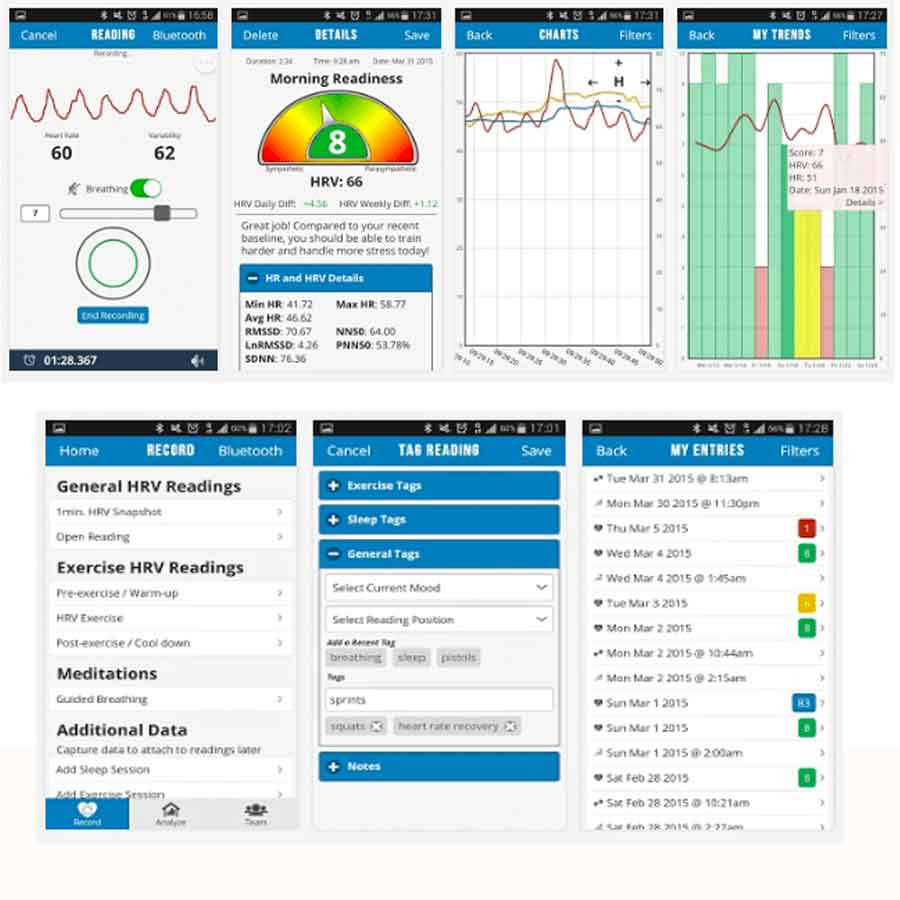
Data-Driven Insights and a Holistic Approach to Well-Being
The Elite HRV Device further distinguishes itself by focusing on actionable insights through its intuitive design. This allows users, from athletes to wellness enthusiasts, to seamlessly interpret data and apply recommendations for both training and recovery. Its holistic approach ensures a balance that supports total well-being.
4. User-Friendly Interface: Incorporates a user-friendly interface for intuitive navigation and seamless interaction. The intuitive design ensures that users, whether fitness enthusiasts or athletes, can easily interpret HRV data and apply personalized training recommendations.
5. Data-Driven Insights: This device uses data-driven insights to empower users with actionable information for optimizing health and performance. By transforming HRV data into practical recommendations, it provides users with a clear roadmap to achieve their fitness and wellness goals.
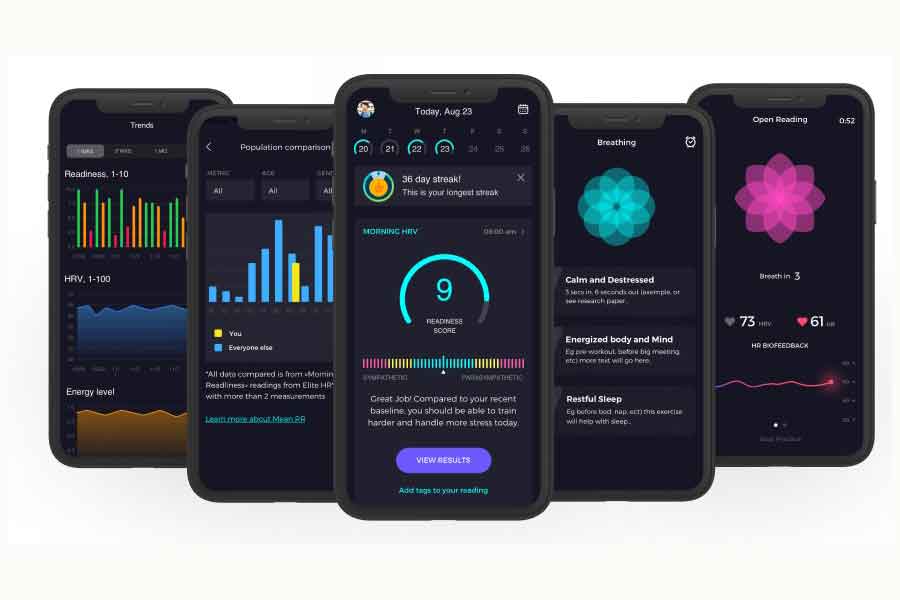
6. Holistic Approach to Well-Being: This device takes a holistic approach by considering both training and recovery aspects for overall well-being. Unlike traditional fitness tracking, it incorporates a comprehensive perspective to support users in balancing training intensity and recovery.
The Elite HRV Training Device emerges as a pivotal tool for individuals seeking precision in optimizing health and performance. It emphasizes comprehensive HRV tracking, personalized recommendations, and holistic training and recovery optimization. Moreover, the user-friendly interface and data-driven insights provide a sophisticated platform for those committed to achieving their fitness and wellness aspirations.
Comparing Biofeedback HRV Devices. What is the Best HRV Biofeedback Device?
Embarking on selecting a Biofeedback HRV device necessitates meticulously considering individual needs, preferences, and desired functionalities. In this comprehensive comparison, we scrutinize and contrast the key features of prominent devices – Biosignals Biofeedback AI-HRV, Biosignals Biofeedback Wireless BLE Finger Device, Biosignals Biofeedback HRV Training Device with 5 Sensors, HeartMath Inner Balance, and Elite HRV training device. Whether you prioritize portability, advanced AI capabilities, extensive sensor arrays, coherence training, or personalized recommendations, this guide empowers you to make an informed decision tailored to your specific goals and lifestyle.
Biosignals Biofeedback AI-HRV One Finger PPG Wireless Sensor
This device delivers nuanced insights with AI-enhanced HRV monitoring and a one-finger PPG sensor. Its AI-driven capabilities make it a compelling option if you seek advanced analytics and effortless data collection.
Key Features:
- AI-enhanced HRV Monitoring
- One-Finger PPG Sensor
- Advanced Monitoring
- Efficient Data Collection
- User-Friendly Interface
- Adaptive Feedback Mechanisms
Ideal For:
- Advanced HRV Analysis
- Effortless Data Collection
- Users seeking AI-driven insights
Biosignals Biofeedback Wireless BLE Finger Device With 3 Sensors
This device, equipped with three sensors for comprehensive monitoring, is tailored explicitly for clinical applications and research. By offering a range of monitored parameters, it meets the needs of healthcare professionals or researchers who require in-depth physiological analysis.
Key Features:
- Comprehensive Monitoring (3 Sensors)
- HRV Metrics, Physiological Responses, Cognitive Measures
- Clinical Applications
- Research Versatility
- User-Friendly Interface
Ideal For:
- Clinical Interventions
- Research Purposes
- Individuals seeking diverse biosignal monitoring
Biosignals Biofeedback HRV Training Device with 5 Sensors
This device caters to professional clinical settings and home-based use, featuring extensive monitoring with five sensors and Bluetooth connectivity. This is a robust choice if you seek a device that adapts to diverse settings, provides advanced HRV metrics, and is versatile.
Key Features:
- Extensive Monitoring (5 Sensors)
- Advanced HRV Metrics
- Physiological Responses, Cognitive Measures
- Bluetooth Connectivity
- Professional and Home Use
- User-Friendly Interface
Ideal For:
- Clinical Professionals
- Home-Based HRV Training
- In-Depth Physiological Analysis
HRV Metrics Provided by BioSignals
BioSignals leverages standard HRV analysis via its OpenSignals HRV add‑on, compatible with their ECG/PPG sensors. According to PLUX documentation, the system computes the following HRV parameters
Time‑Domain Metrics
- RRI & NNI tachogram (beat-to-beat interval series)
- Min/Max/Mean NNI (inter‑beat intervals)
- SDNN – standard deviation of NN intervals
- RMSSD – root mean square of successive differences
- NN20 / pNN20 – counts/proportion of interval differences > 20 ms
- NN50 / pNN50 – counts/proportion of interval differences > 50 ms
- Mean heart rate
Frequency‑Domain Metrics (via Welch’s method)
- VLF, LF, HF power components
- Absolute and normalized LF & HF powers
- LF/HF ratio (balance between low and high frequency)
Nonlinear Metrics
- Poincaré plot parameters: SD1, SD2, and SD1/SD2 ratio
HeartMath
HeartMath Inner Balance emphasizes emotional well-being and stress reduction through coherence training exercises. This device’s specialized features make it a standout option for cultivating emotional resilience and managing stress.
Key Features:
- Real-time HRV Monitoring
- Coherence Training Exercises
- Emphasis on Emotional Well-Being
- User-Friendly Interface
- Portable and Convenient
Ideal For:
- Emotional Resilience
- Stress Reduction
- Individuals prioritizing emotional well-being
Elite HRV training device
With comprehensive HRV tracking, personalized training recommendations, and a holistic approach to well-being, the Elite HRV device caters to fitness enthusiasts seeking customized insights. If you prioritize optimizing both your training sessions and recovery periods for overall well-being, this device provides a tailored solution.
Key Features:
- Comprehensive HRV Tracking
- Personalized Training Recommendations
- Optimizing Training and Recovery
- User-Friendly Interface
- Data-Driven Insights
- Holistic Approach to Well-Being
Ideal For:
- Fitness Enthusiasts
- Performance Optimization
- Individuals seeking personalized insights
Selecting the best HRV biofeedback device hinges on aligning its features with your unique preferences and goals. By understanding the unique strengths of each device and how they align with specific use cases, you can confidently choose the Biofeedback HRV device that best suits your needs and preferences.
Optimal Training: A Step-by-Step Approach with Your Best HRV Biofeedback Device
Getting Started with Your HRV Biofeedback Device
In this pivotal chapter, we embark on a journey toward optimal training using your HRV Biofeedback Device. The following step-by-step guide empowers you to maximize the benefits of HRV training, enhance your well-being, and achieve a harmonious balance in your autonomic nervous system.
Step 1: Device Familiarization
Begin by familiarizing yourself with the features and functionalities of your HRV Biofeedback Device. Understand how to navigate the interface, initiate HRV monitoring, and access real-time data. This foundational knowledge sets the stage for a seamless training experience.
Step 2: Establish Baseline Measurements
Initiate your HRV monitoring session to establish baseline measurements. This snapshot of your autonomic nervous system’s activity is a reference point for future comparisons. Take note of your HRV metrics, including SDNN, RMSSD, LF, HF, and LF/HF ratio.
Step 3: Identify Stressors and Triggers
Utilize your device’s biofeedback capabilities to identify stressors and triggers in your daily life. Observe how your HRV patterns fluctuate in response to different situations, environments, or activities. Recognizing these patterns empowers you to manage stress proactively.
Optimizing and Personalizing Your HRV Training
Step 4: Tailor Biofeedback Sessions
Engage in biofeedback training sessions based on the insights gained from your baseline measurements and stressor identification. Additionally, leverage the device’s coherence training exercises, adaptive coaching features, or personalized recommendations to tailor sessions that align with your well-being goals.
Step 5: Monitor Progress and Adjust Training
Consistently monitor your HRV trends over time. Track the changes in your baseline measurements, stress responses, and overall HRV patterns. Adjust your biofeedback training sessions accordingly, optimizing the duration, frequency, or focus areas based on your evolving needs and objectives.
Step 6: Integrate Adaptive Training Plans
If your HRV Biofeedback Device offers adaptive training plans, consider integrating them into your routine. These plans dynamically adjust based on your real-time physiological responses, ensuring your training aligns with your body’s current state and needs.
Step 7: Reflect and Refine
Reflect regularly on your HRV training journey. Note improvements in stress resilience, emotional well-being, and overall performance. Refine your approach by incorporating mindfulness techniques, relaxation strategies, or lifestyle adjustments that complement your HRV training efforts.
Step 8: Consult with Professionals
Consider consulting healthcare professionals, fitness experts, or biofeedback specialists for a holistic and personalized approach to optimal training. Their insights can provide additional guidance, ensuring your HRV training aligns with your health and wellness goals.
By following this step-by-step approach, you’ll unlock the full potential of your HRV Biofeedback Device, fostering a journey towards optimal training, stress resilience, and overall well-being. Embrace the process, stay attuned to your body’s signals, and enjoy the transformative benefits of integrating HRV training into your daily life.
Breaking Barriers: Addressing Common Misconceptions in HRV Training Devices
Debunking Myths Surrounding HRV Training Devices
Misinformation and misconceptions about HRV training devices can hinder individuals from fully embracing their transformative potential. In this chapter, we debunk prevalent myths and misconceptions about HRV training devices, empowering you with accurate information to make informed decisions about integrating them into your wellness journey.
Myth 1: HRV Training is Only for Athletes
Reality: While athletes can benefit significantly from HRV training, it is not exclusive to them. HRV training devices are versatile tools suitable for individuals of all lifestyles and fitness levels. Whether you’re a professional athlete or someone seeking stress management, HRV training can be tailored to your unique needs.
Myth 2: HRV Training is Complex and Time-Consuming
Reality: HRV training devices are designed with user-friendly interfaces and streamlined functionalities. Thanks to advancements in technology, these devices provide efficient and time-conscious solutions. As a result, training sessions can be adapted to fit various schedules, making them accessible for those with busy lifestyles.
Myth 3: HRV Devices Are Only for Monitoring, Not Training
Reality: Contrary to the misconception that HRV devices merely monitor physiological data, many offer interactive biofeedback training. Coherence exercises, adaptive coaching features, and personalized training plans are integral components, allowing users to actively engage in their wellness journey rather than just passively monitoring.
Myth 4: HRV Training Devices Are Expensive and Inaccessible
Reality: While there are high-end HRV training devices, the market offers a range of options with varying price points. Moreover, the long-term health benefits and stress reduction achieved through HRV training can outweigh the initial investment. Accessibility has also increased with the introduction of more affordable and portable devices.
Discovering the True Potential of HRV Training Devices
Understanding the measurable results and holistic wellness benefits of HRV training can encourage you to embrace its potential fully.
Myth 5: Results Are Not Measurable or Tangible
Reality: HRV training provides tangible results that extend beyond mere numbers. Users can track improvements in stress resilience, emotional well-being, and overall performance. Visual representations of HRV trends offer clear insights into progress, ensuring the benefits are measurable and meaningful.
Myth 6: HRV Devices Are Only for Managing Stress
Reality: While stress management is a significant aspect of HRV training, these devices offer holistic wellness benefits. Users can optimize training routines, enhance recovery, and improve overall well-being. The versatility of HRV training extends to various facets of physical and mental wellness.
Myth 7: HRV Training Requires Specialized Knowledge
Reality: HRV training devices are designed to be accessible to users with varying levels of expertise. In addition, the intuitive interfaces and user-friendly apps eliminate the need for specialized knowledge. As a result, these devices guide users through the training process, making it easy for anyone to incorporate HRV training into their routine.
By debunking these common myths, we aim to eliminate the obstacles that may have prevented you from exploring HRV training devices. Furthermore, these devices offer a versatile and accessible way to enhance well-being, regardless of your fitness level or lifestyle. Ultimately, embracing the reality of HRV training will help you unlock its transformative potential for improving your health and resilience.
FAQ: Best HRV Biofeedback Training Device
An HRV (Heart Rate Variability) biofeedback device measures the variation in time between heartbeats, offering insights into your autonomic nervous system. These devices help you improve stress resilience, recovery, and overall well-being by providing real-time feedback that supports personalized training and relaxation.
HRV reflects the balance between your sympathetic (fight-or-flight) and parasympathetic (rest-and-digest) nervous systems. Higher HRV usually indicates greater adaptability and recovery capacity, while lower HRV may signal stress, fatigue, or health imbalances.
- Improve stress management
- Optimize athletic training and recovery
- Enhance sleep quality
- Support cardiovascular and metabolic health
- Aid in mental focus, emotional regulation, and cognitive performance
- Assist in managing conditions like anxiety, PTSD, TMJ, and fibromyalgia
Common HRV metrics include:
- SDNN (Standard Deviation of NN intervals)
- RMSSD (Root Mean Square of Successive Differences)
- LF/HF ratio (Sympathetic-Parasympathetic balance)
- HF & LF Power (Frequency domain indicators)
- pNN50, coherence, and entropy (Advanced variability and complexity indicators)
Absolutely. Biofeedback exercises guided by HRV devices help regulate breathing, improve vagal tone, and increase parasympathetic activity, reducing stress and improving emotional balance over time.
Some users notice initial improvements in stress levels, breathing, or focus within a few sessions, especially with guided biofeedback exercises. However, achieving lasting and consistent results typically requires regular practice over 4 to 8 weeks. Long-term use strengthens autonomic balance, improves stress resilience, and helps integrate healthier responses into daily life. Just like physical fitness, consistency is key to success.

